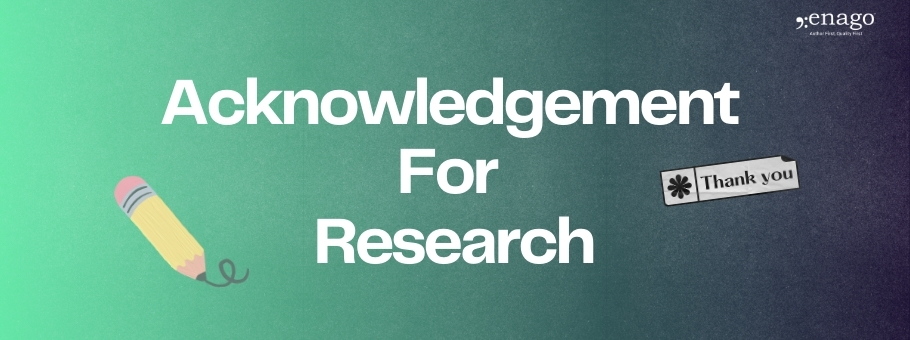Crafting an Effective Acknowledgement for Research

Acknowledgments serve a crucial function in academic research, offering formal recognition of the myriad supports and contributions that enable the successful completion of a study or project. This can include anything from financial backing provided by institutions to the emotional encouragement from peers and mentors. Including a thoughtfully composed acknowledgment not only reflects professional integrity but also enhances collaborative ties within the academic community. In this article, we explore the intricacies of constructing impactful acknowledgments and provide insights on best practices to craft Acknowledgement for Research.
The Importance of Acknowledgments in Academic Research
Acknowledgments present an invaluable opportunity to thank the individuals, institutions, and organizations that have been instrumental throughout your research journey. Their importance goes beyond just expressing gratitude; they also add transparency and enhance the credibility of your work. A well-designed acknowledgment section can:
- Validate Academic Integrity: Publicly recognizing contributors ensures adherence to ethical standards, thereby avoiding potential accusations of oversight or plagiarism.
- Strengthen Collaborative Networks: Appropriately crediting individuals can enhance your professional network and promote reciprocity in future research endeavors.
- Ensure Funding Transparency: Acknowledging financial support and institutional backing complies with funding agency criteria, reinforcing the integrity of your research.
Core Components of an Acknowledgment Section
Acknowledgments can encompass various facets, ranging from moral support to financial contributions. According to bibliometrics researchers such as Cronin et al., six fundamental categories of acknowledgments have emerged:
- Moral Support: Emotional encouragement received from friends, colleagues, or family members.
- Financial Support: Grants, scholarships, or funding from institutions or agencies.
- Editorial Support: Assistance in proofreading, editing, and revising drafts.
- Presentational Support: Help with visuals, presentations, or formatting tasks.
- Technical or Instrumental Support: Guidance on utilizing specialized tools, software, or laboratory equipment.
- Conceptual Input: Critical discussions, peer reviews, and idea exchanges with colleagues or mentors.
These categories ensure that all forms of support, whether intellectual or logistical, are acknowledged systematically.
Structuring a Research Acknowledgment Section
Creating an acknowledgment section requires a thoughtful approach to balance clarity and precision. Here’s a systematic guide:
1. Begin with a General Gratitude Statement
Start with a general expression of thanks to establish a tone of appreciation. Example: “I am profoundly grateful to all who contributed to the success of this research.”
2. Categorize and Acknowledge Contributors
Organize your acknowledgments based on the type of contributions.
- Personal Acknowledgments: Recognize family and friends who provided moral support.
- Institutional and Financial Acknowledgments: Mention funding agencies or academic institutions that offered resources.
- Professional Contributions: Include mentors, advisors, and anyone who provided intellectual support.
3. Adopt a Hierarchical Structure
Arrange your acknowledgments from general to specific. A typical order may include:
- Funding organizations.
- Advisors and mentors.
- Colleagues and collaborators.
- Editorial and technical support.
- Family and friends.
4. Maintain Concise Language
Keep the acknowledgment section clear and succinct. Avoid overly emotional language or lengthy narratives.
5. Verify Funding Agency Guidelines
Many funding organizations have specific acknowledgment criteria, such as requiring their logos or grant numbers. Be sure to follow these standards.
Common Pitfalls in Research Acknowledgments
While expressing gratitude seems simple, there are a few common pitfalls that researchers should avoid:
- Overly Personal Tone: Keep the language formal and professional.
- Excessive Flattery: Use clear and direct language; avoid vague or exaggerated expressions.
- Neglecting Key Contributors: Omitting significant supporters might raise ethical concerns.
- Spelling Errors: Always verify names, institutional affiliations, and funding details for accuracy.
Effective Practices for Crafting Acknowledgments
To ensure your acknowledgments resonate, consider these actionable practices:
- Plan Acknowledgments Early: Track contributions throughout your research to facilitate a smoother acknowledgment process in your final draft.
- Adapt to Your Field: Different academic disciplines—like medical sciences or humanities—may have specific acknowledgment expectations.
- Refer to Formal Templates: Academic journals often provide templates that can guide your formatting.
- Seek Feedback: Review your acknowledgment draft with peers or mentors to improve clarity and adherence to academic norms.
Real-Life Acknowledgment Examples
To illustrate effective acknowledgment writing, consider these examples:
- Financial Support: “This research was made possible through the XYZ Grant (Grant No. 12345) from the National Institute of Research, which enabled all experimental activities.”
- Moral Support: “I am deeply grateful to my family for their unwavering support through this project.”
- Conceptual Contributions: “Thank you to Dr. John Smith for his insightful critiques and contributions that greatly enhanced this study.”
- Technical Assistance: “I wish to acknowledge the laboratory staff at ABC Institution for their assistance with data collection.”
How Enago Can Enhance Your Acknowledgment Section
Crafting a refined acknowledgment section requires diligent attention to detail, tone, and adherence to guidelines. Enago’s professional editing and proofreading services ensure that your acknowledgment aligns with academic and publishing standards. With vast experience in enhancing research manuscripts, Enago provides tailored solutions.
Acknowledging contributions is pivotal for reinforcing the credibility of your work. Whether it’s recognizing technical expertise or emotional support, a well-composed acknowledgment nurtures robust academic relationships and paves the way for collaborative and impactful research in the future.
Research Acknowledgments: Frequently Asked Questions
What are the key components to include in a research acknowledgment section?▼
Key components of a research acknowledgment section include expressions of gratitude, categorization of contributions, and a hierarchical structure. Start by thanking contributors broadly, then specify personal acknowledgments, institutional support, and professional contributions. This approach enhances clarity and shows appreciation for both moral and financial support received throughout the research process.
How should researchers structure their acknowledgment section for maximum impact?▼
Researchers should structure their acknowledgment section starting with a general gratitude statement, followed by categorized contributions. Organizing acknowledgments from funding sources to personal support helps maintain clarity. Use succinct language and formal tone while adhering to any specific guidelines set by funding agencies to ensure transparency and professionalism.
What common mistakes should researchers avoid when writing acknowledgments?▼
Common mistakes include using an overly personal tone, excessive flattery, failing to acknowledge significant contributors, and overlooking spelling errors. These missteps can diminish the professionalism of the acknowledgment section, potentially raising ethical concerns. Maintaining a formal tone and ensuring complete accuracy are crucial for a credible acknowledgment.
How can acknowledging contributions enhance academic integrity in research?▼
Acknowledging contributions enhances academic integrity by publicly recognizing the support that enables scholarly work. This transparency helps avoid accusations of oversight or plagiarism. Properly citing support—from financial backing to intellectual input—reinforces credibility within the academic community and fosters trust among stakeholders in the research process.
What are effective practices for crafting acknowledgment sections in research?▼
Effective practices for crafting acknowledgment sections include planning contributions early, adapting to disciplinary conventions, using formal templates, and seeking feedback. Tracking support throughout the research process ensures a comprehensive acknowledgment. These strategies not only enhance the clarity of the section but also align it with academic and publishing standards.




